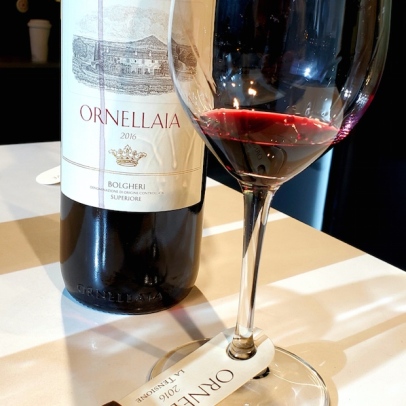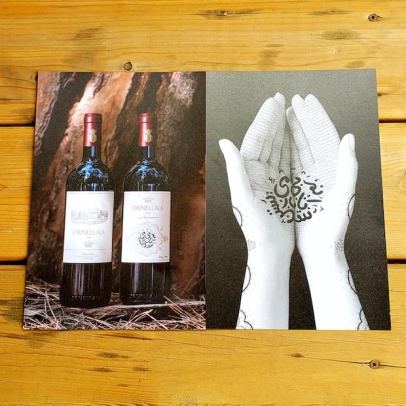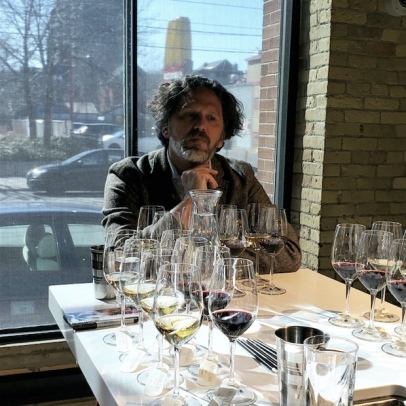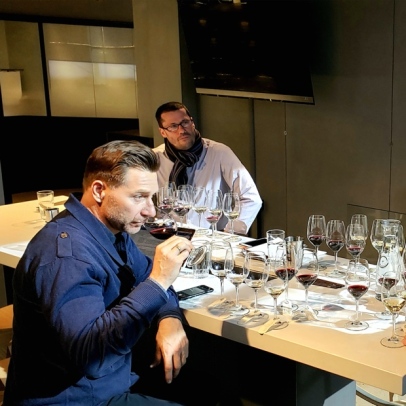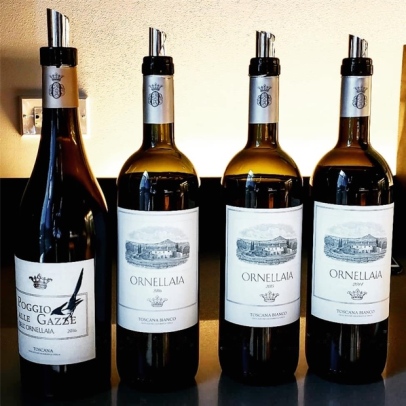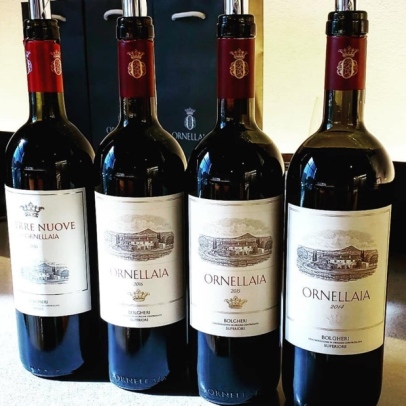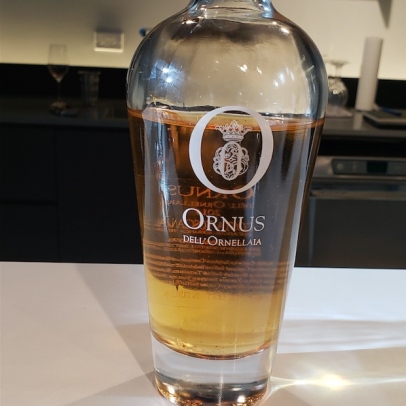Bolgheri’s virtues and the tension of Ornellaia
A meeting with Estate Director Axel Heinz to discuss Bolgheri, the 2016 vintage and La Tensione, plus mini-vertical tastings of Ornellaia Bianco and Rosso
by Michael Godel
Ornellaia is a name that graces one of the most recognizable labels of elite red wines in the world. The estate is a bey of Bolgheri and a capo of Toscana. Most famous is the Bolgheri DOC Superiore Rosso, a cabernet sauvignon based cuvée derivative of the Left Bank Bordeaux model, with merlot, cabernet franc and petit verdot. It was created out of a “desire to nurture the estate’s exceptional qualities that has shaped Ornellaia’s philosophy since the beginning.” It was but a few weeks ago that John Szabo M.S. and I sat down with Estate Director Axel Heinz in the offices of their Ontario agent Mark Anthony Brands for mini-vertical tastings of Ornellaia Bianco and Rosso, plus a discourse on the 2016 vintage and the morphology of Ornellaia.
The estate’s Toscana IGT Bianco is primarily produced with sauvignon blanc coming from three small vineyards that have also demonstrated a remarkable capacity to express the unique character of Ornellaia. The Bianco was first introduced in 2013, following and extrapolating from the original 1980s and 1990s footsteps of Poggio alla Gazze, the other Ornellaia white that resumed production in 2008 after a six-year hiatus from making such wines. The resurrected white owes its elegant Mediterranean style to a unique micro-climate, predominated by sauvignon blanc of firm structure, ripe fruit and finesse. The renewed IGT Bianci are officially in the conversation of great whites forged with sauvignon blanc.
There is Le Serre Nuove Dell’Ornellaia, produced since the 1997 vintage, from younger vines and with the intent to produce a ripe and approachable wine. Ornellaia’s are wines, vintage in and vintage out, of phenolic exceptionality, complexity, refreshing acidity, Tuscan spiritualism and no parochial parallel. The Ornellaia Rosso is consistently equipped with fine-grained and chalky tannins that follow chains in a world spinning ’round in lush circles. Da Vinci muscled cherubs Renaissance blends and the reference point for such assemblage in Bolgheri. Stealthy, animale motionless, timeless, steadfast and true.
La Tensione – Vendemmia d’Artista
It begins with the phrase. La Tensione. Its literal translation “the tension” does not do justice to Ornellaia’s intentions, nor to the latent manifold levels of meaning, interpretation or states of grace. La Tensione may also mean “the effort,” or sforza, but it may also make us think in terms of potential difference, differenza di potenziale. Tension often refers to a high strung bow or the taut and flexed action of a muscle. It also lends a consideration about the structure of a wine in which balance is achieved through the perfect alignment of fruit, acidity and tannin. Which brings us to the Ornellaia Rosso and to how the 2016 is so aptly named.
Beginning with the 2006 vintage, the Tuscan estate launched a special art project, purposed to celebrate the unique character of each new vintage matched by an artist’s interpretation of that vintage. Since 2009 Ornellaia has donated all the proceeds from Vendemmia d’Artista charity auctions, generously overseen by Sotheby’s, in favour of art foundations and museums all over the world.
Back in the 2011 vintage and through its association with Vendemmia d’Artista, the “Infinity” character or L’Infinito was interpreted by Canadian born artist Rodney Graham. Graham created a work of art and a series of exclusive labels for large format bottles. Each one individually signed and numbered and adorned 100 three-litre Double Magnums, 10 six-litre Imperials and a unique nine-litre Salmanazar. An auction was held at the AGO and raised $126,000 for the institution. Since 2012 the Vendemmia d’Artista project has been extended to each case of Ornellaia in which one (750 mL) bottle out of six has a special label designed by the artist.
For the 11th edition of Ornellaia’s Vendemmia d’Artista and to coincide with the release of the 2016s, the next internationally renowned contemporary artist chosen was Shirin Neshai, an American-Iranian visual artist who lives in New York City, known primarily for her work in film, video and photography. Her earliest works were series of photographs exploring the political and social conditions of Iranian and Muslim life, with a focus on women’s issues. She them moved into more poetic imagery and narratives. Neshai’s commission was to create a work of art for the estate, a series of limited edition labels and an interpretation of Ornellaia 2016, called La Tensione. The connection is made with her “disruptive and poetic visual language, her dynamism and strength through the words of the illustrious 11th century Persian poet Omar Khayyam.” The large format bottles are auctioned off to be delivered to the cellars of lucky collectors and from 2019 the proceeds are donated to the Solomon R. Guggenheim Foundation in support of an innovative project called “Mind’s Eye.”
The program was created by the Guggenheim’s education department to help individuals who are blind or have low vision to experience art through all of their senses. Museum programs are designed to invoke the senses and expand the possibilities for making imaginative impression and emotional connections. Shirin Neshai’s labels offer another kind of connection, from which “wine acts as a moment of social sharing, a life force that according to Khayyam should be enjoyed during our brief time here on earth.” The labels represent details of female faces, hands and bodies which are completely covered by Farsi calligraphy. The imagination is engaged by the juxtaposition of skin, graphics and text.
The 2016 Growing Season
In the current throes of what farmers and those who will not deny the inevitable collectively refer to as “climate change” we take note of the increasing norms, of abnormally warm Tuscan weather that in 2016 included heavy February rainfall. Plenty of soil moisture and heating April temperatures meant early and quick vegetative growth. It was a normal summer with an abnormal absence of August tempests. Early harvest hydric stress was mitigated by cool nights for sure and steady ripening. Late September showers were a blessing and moderate warmth meant no vine shutdown. What began with merlot on August 24th wrapped up on October 12th with cabernet sauvignon and petit verdot. In terms of potential, any vintage that sees a 50-day window for harvest can only be categorized as a great one.
Writes Heinz, “2016 represents another immensely successful vintage highlighting all the virtues of Bolgheri’s climate; abundant sunshine without excessive heat, a dry summer to allow the grapes to achieve perfect ripeness and concentration. Just enough rain to avoid stress. All these elements combine to yield a wine that shows lush ripeness and crisp firmness, opposing forces creating a certain raciness we like to describe as tension.”
A bit of historical perspective
In the mid to late 1970s Tuscany there developed a quick ascent of the Super-Tuscan, wines that eventually came to be called “IGT” as a by-product of a perfect bureaucratic storm. The micro-nationalistic wave of Denominazione di Origine Controllata (e Garantita) served Italy’s elite producers both a blessing and a curse because on one hand it afforded wines the highest level of (Italian) classification while on the other it added unbending restrictions on how those wines could be made. The rule breaking table reds thus became symbols of resistance, wines that told governments and consortiums where to go and in effect led to an eventuality of response, of a sweeping, money-grabbing movement across that region’s wine-producing territories.
It was nigh twenty years later that authorities got wise to the situation and so Goria’s 1992 Law 164 was created, thus giving birth to the IGT designation. New monies began to line the government’s pockets. So much for rebellion though twenty years was plenty of time to establish and set up a group of famous wines for life.
The wave began as Chianti Classico producers began to dismiss appellative laws by de-classifying their not permitted 100 per cent sangiovese. Fontodi’s Flaccianello and Isole e Olena’s Cepparello are two of the more famous examples. Outside the Classico territory and in other Tuscan lands there were the most rogue and famous of them all. Tenuta San Guido’s 1968 Sassicaia, Antinori’s 1971 Tignanello, 1986 Masseto and Ornellaia, first produced in 1985. Since 2004-2005 the Tuscan archetype for cabernet sauvignon based Bordeaux blending reds has been under the auspices of production by the family Frescobaldi and incidentally the same period of time that current winemaker Axel Heinz joined the team.
It’s no secret the heart’s soft spot will gladly make room for fine and expensive wine, but not all will walk through that open door to gain your trust. One of the softest spots is for Ornellaia and the iconic association with Frescobaldi has so much to do with that feeling. The Rosso is always a gorgeously perfumed principessa. These new tastings and still others previously tasted together perpetuate the notion.
Timeline*
1981 – Founded by Lodovico Antinori, with advice from consultant André Tchelitscheff
1982 – First plantings at the estate
1985 – First vintage of Ornellaia
1987 – First vintage of Masseto and of Poggio alle Gazze
1989 – Tibor Gál from Hungary appointed winemaker. Winery completed
1991 – Michel Rolland taken on as consultant
1997 – Le Serre Nuove introduced as Ornellaia’s second wine
1999 – Mondavi takes a minority share in the estate
2001 – Poggio alle Gazze discontinued
2002 – Mondavi, together with Frescobaldi, acquires a controlling interest in Ornellaia
2005 – Frescobaldi buys out Mondavi’s share and becomes sole owner. Axel Heinz appointed as winemaker
2008 – Poggio alle Gazze revived as the estate’s Sauvignon Blanc based white wine
*source (decanter.com)
Ornellaia is the benchmark for Super Tuscan solicitude. It pours with pleasure. It reminds us of what was once good and approachable in what can so often be a pretentious and elitist world of expensive wine. It resembles its directors, leaders who come to Toronto as patrons of the arts and as stewards of wines grounded in philanthropic nature. A morning spent with Axel Heinz and Ornellaia is the reference point for such assemblage in Bolgheri. A world spinning ’round in lush circles, of perfume in poured glasses filling the air. The edenic garden of Ornellaia. These are my notes on the wines tasted with Axel Heinz.
The Bianco was first introduced in 2013, following fast forward to the original 1980s and 1990s work with Poggio alle Gazze dell’Ornellaia. That project had been abandoned because says Axel Heinz “stylistically it just wasn’t right.” That wine was mainly sauvignon blanc on one of Ornellaia’s great vineyard sites. What was wanted was something more than a varietal wine and a new age of finding vineyard sites that were more than merely good for white wine. That means making use of northern slopes and those blocks favourable to whites, including the use of (indigenous) vermentino and viognier. The practice had already been proven with success by colleagues. Bianco is the alter ego to the Rosso, priced as such “and reflects the spirit of Ornellaia, but it had to build itself up to that premium level. We intend to make one of the great white wines of the world,” explains Heinz. That may sound like bragging swagger but the reality is that experience, acumen and especially confidence breed the truth. I Bianci are aged for 12-15 months in (30 per cent new) barriques before bottling. I do dare you to find a wine that smells anything like this Bianco. They are flowers unnamed or perhaps not yet discovered. The flinty reductiveness is also truly and wholly unique. Though the way sauvignon is raised and the place are surely not the same, the Bordeaux styling and sensibility of affinities are more than uncanny and even served by purpose. The vintage brings great maturity, fruitiness and salinity. Fruit presence under the spell of fleur de sel. Nothing but a brilliant combination. Says Heinz without equivocation, “it’s a benchmark for us, ’16 that is.” Drink 2020-2031. Tasted March 2019
From white blend to varietal wine, in 2015 Bianco sheds the viognier and petit manseng to go it alone. “At the end of the day we feel that sauvignon blanc is the white variety best suited to this wine from these vineyards,” tells Axel Heinz. True to this it is the non-additions that allow full lift and vintage accentuation of florality and sapidity to hold true for the plan. The weather was normal but still marked by some extremes. Summer heat caused some concern but mid-August rain levelled the ripening playing field and allowed for a stress-free late summer pick. The élevage followed suit to ’14 with 12 lees sitting months in (30 per cent) new barriques. The fruit is at its height, perhaps exceeded by ’16 but still very typical, normal and fleshy. It’s a bit smoky and flinty but fruit, in peach, citrus and even something exotic are all at the fore. Wonderful length, presence and distinction. Drink 2019-2027. Tasted March 2019
Axel Heinz is behind the white wine revolution for Ornellaia and where the vintage deficiencies of 2014 might add up to a comparatively lower level of fruit fleshiness, it more than makes up for in sapidity, salinity, focus and precision. The lack of hydric vintage stress means that freshness is a blessed guarantee. The blend is sauvignon blanc dominant (74 per cent), with floral and tropical viognier (13) plus high acid petit manseng (13). “We did not want to fall into the trap of making a formulaic and in your face white wine…and one that followed along with our philosophy. Not the trap of making a superficially fantastic wine.” Bianco is a white wine that realizes its aromatic potential, with texture derived by 12 months on lees in (30 per cent new) barriques.The cool factor, minty or otherwise attracts the attention of many more pressure and nerve points in parts of the mouth that ’15 can’t access of even find. So much vitality comes into the clear fibres and lines of the sensory department. It’s astonishing really. Drink 2019-2028. Tasted March 2019
Poggio Alle Gazze Dell’Ornellaia 2016
The production of Poggio alle Gazze was resumed in 2008 after a half decade-plus (2002 onwards) hiatus from making any estate white wines. Most of the vines were either ripped out or grafted to varieties like merlot but a small plot’s barrel full of sauvignon blanc survived through the interim and thus began the new era, still with a link to the original score. The oldest vines at this point were planted in 1999. So here we are, with sauvignon blanc, vermentino and viognier together chiming chic, stylish, open-hearted and textured of threefold recognition. Half of the wines find their way into barrel, 25 per cent of it new, plus nine months aging on the lees. It’s a viscous white, like liquid white flowers, metal-molecular gastronomy and fruit more remindful of peach than anything else. A wine to speak of a consumer’s modern retention and renewed attention towards white wine. So recognizable as warm, ripe and fleshy Tuscan white wine obviated away from banal and doing so at a very high level. Drink 2019-2025. Tasted March 2019
606194, Le Serre Nuove Dell’Ornellaia 2016
Le Serre Nuove is a second wine to Ornellaia Rosso in every way that Pogio alle Gazze is not to the Toscana Bianco. There is little doubt about the concentration in 2016 and this may just be the most impressive Serre Nuove in its earliest days. The fruit is so dominant, raging with blackberry and Cassis integrated into a perfectly ripe and fine-grainy liquid chalky consistency. You might expect no grip but au contraire this Serre Nuove is fully formed, firm and in command of what structure it needs to supply. Last tasted March 2019
Ornellaia’s second wine is at its fruit-forward, full-flavoured peek out of the warm 2016 vintage. The texture folds over and over upon itself with espresso, chocolate and more than enough length to go around and around. The acids are firm and the tannins dry and coating. This hits the proverbial nail on the head for what you’ll feel from sipping on this fulsome and pulchritudinous blend. Drink 2019-2025. Tasted October 2018
722470, Ornellaia ‘La Tensione’ 2016
Ornellaia 2016’s moniker is “La Tensione,” which is a bit ironic when you consider the generosity of the vintage. The name was chosen because of the balance provided by these highly specialized and discreetly formidable 2016 tannins, bringing together the tenets of fruit richness and structured grip, but in the end it speaks the truth and “should be taken quite literally.” So 2016 is the pinnacle to this point in so may ways, as a culmination of everything learned by this team of über professionals and the wisdom developed by a mature vineyard. And because when it comes to the heart and soul of the vineyard it is in fact the terroir that has not changed. The weight and pressurized control is formidable, even while the wine remains just a bit dusty and muted. There is a peppery note to ’16 and a seamlessness of texture through structure that is not hard to find, even in such a youthful state. Let’s see how this chooses to travel and to where, once it has opened up. Forget speculation and just deal with reality because Ornellaia speaks the truth. Drink 2022-2034. Tasted March 2019
722470, Ornellaia ‘Il Carisma’ 2015
Generosity is marked in depths defined and initiated by fruit found in the present’s perfect position. The equitable distribution of 2015 ripening travels through the glass with negative travail. Il Carisma as it is affectionately known is a right and proper moniker for an Ornellaia that really sings and does so with layers upon layers of verse and refrain. The word takes you to a place and a memory where the song played and everything was grand. E col carisma del visionario, equates Il Carisma to Il Presidente, in Tuscany, Italy and di tutto il mondo. Few vintages have accumulated such richness, tension and verse, finishing with the uncanny ability to temper quality chocolate. Last tasted March 2019
In 2015 Ornellaia is Il Carisma, continuing the Vendemmia d’Artista program established in 2006. The artist’s interpretation here is from William Kentridge and it is some old-school wine gathering and multi-apparatus making notions that are rendered. The 2015 is a smooth and balanced Ornellaia, clearly earmarked for positive drinking and not necessarily the sort of structure of some other firm and intense vintages. There is an uncanny note of cinnamon, not noted ever before, but also some fennel and dark raspberry. Very silky, good quality acids and huge into dreamy flavours. Drink 2020-2029. Tasted October 2018
722470, Ornellaia ‘L’Essenza‘ 2014
It’s a didactic tough act to follow with 2016 and 2015 ahead but the savoury, mineral and just extraordinary sapidity of the vintage for the Grand Vin speaks to its singularity and unprecedented focus. The message here is clear, for a place that has entered an era in epoch, of a red wine that ranks with Italy’s most important and delivers fruit put up on a pedestal of rock, earth and salt. The elegance and restraint are not seen in others and while under certain microscopes this may seem to some as showing deficiencies it is surely an extraordinary Ornellaia. Last tasted March 2019
Ornellaia faces perhaps one of its greatest challenges of the century (and second only to 2002) with thanks to the weather. Perhaps a bit easier in Bolgheri but ’14 placed many obstacles in the way and as only an archetype Tuscan can do, it faces them head on. It’s quite fullish, bullish and brave, with plenty of wood spice, chocolate and espresso. Acidity is preserved to ensure a 10-15 year aging period though fruit is not the proudest or most conceited ever from this great bottle. I like the humility and vintage understanding however, especially from a house often setting the leading example of Super Tuscans working the warmer vintages to full advantage. The adversity of 2014 makes Ornellaia work with the opposite and in the end it’s a fresher kind of fleshier Grand Vin. Drink 2018-2027. Tasted November 2017
This is Ornellaia’s late harvest dessert wine made from 100 per cent petit manseng grown on soils of small pebbles and limestone. The pressing and fermentation are long, as can be the window of harvest, happening in some vintages as early as late September but most likely in mid to late November. A year in 100 per cent new barrel is followed by two years in bottle before release. The high acid variety is mirrored by the deepest, richest and most blessedly ripened apricot, quince and soft cachi (persimmon) fruit, glazed dutifully by pineapple and shot through the heart by ripping acids. Though the other dessert wines of the region (namely Vin Santo) can offer so much biscotti and nutty dessert pairing pleasure this sticky by the famed Bolgheri house offers so much sapid, stretchy and candied confiture with pleasure as if by the sea. It’s an explosion of fruit and possibility. Drink 2019-2034. Tasted March 2019
Good to go!
godello




